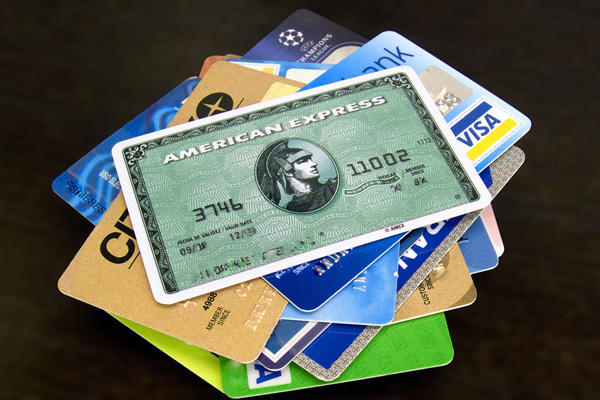| Balance | Snowball Order | Minimum Payment | Total Payment | ||
| Card 1 | $3,000.00 | 3 | $75.00 | $75.00 | |
| Card 2 | $1,500.00 | 2 | $38.00 | $38.00 | |
| Card 3 | $800.00 | 1 | $20.00 | $320.00 | *First card to payoff |
| Card 4 | $5,000.00 | 4 | $125.00 | $125.00 | |
| Totals | $10,300.00 | $258.00 | |||
| Monthly Surplus | $300.00 |

According to recent studies by Experian and TransUnion, the average American has at least two credit cards and approximately $4,878 in credit card debt. For some of us, that number can be as high as $8,000.
For many service members and their families, even thinking about how to pay off these debts is inconceivable. The weight of this debt not only burdens them financially, it affects them emotionally as well.
The good news is that paying off credit card debt can be a lot easier than you think. The most important thing is to develop a plan and stick to it come hell or high water. It may feel tough at first, but before you know it, you’ll be in a much better personal and financial situation!
However, before you develop your plan, you must accept three main truths.
You cannot use your credit cards under any circumstances.
It’s the financial equivalent of spending the morning on a treadmill, only to eat a large pizza for dinner. Credit cards can become an addiction. Like most unhealthy things, you need to kick the habit and cold turkey is the way to go.
This may take a while and it won’t be fun.
Few things worth doing are easy, and that includes ridding yourself of credit card debt. Don’t believe the late-night TV commercials or ads on the Internet.
You need to be honest with yourself about what you can afford.
Many of us get into trouble with credit cards because we spend more than we’re actually taking in, and credit cards offer a convenient way to make up the difference. If you want to make a meaningful dent in your debt, you need to dedicate as much as you can afford to pay it off.
Once you, and your family, have committed to making a change, you can get started on your plan.
Step 1 – Create a Budget (and Stick to It)
Sit down with all of your bills and a good idea of what you spend on a monthly basis. Take your fixed expenses (stuff you know you’ll have to pay) and put them in one column. Make sure to include the minimum payments on all of your credit cards in the fixed column.
Take your variable expenses (stuff that changes from month to month) and put them in another column.
Then, take your monthly income and subtract all of your fixed and variable expenses to determine your monthly surplus.
Hopefully, there’s some left over. If not, go back to your variable expenses and see if there’s anything you can do to cut costs. What’s left over is what we’re going to use to pay off the credit cards.
Your monthly surplus is what we’ll use to start making a dent in your debt.
Step 2 – Find Out Your Balances and Interest Rates
Not all credit cards are created equal. Different cards have different rates and understanding how much you owe at what interest rate is the key to getting the most bang for your debt-reduction buck.
Make a list of all of the credit cards you have, and include their current balance and the interest rates. Make sure to note if that rate is promotional (0% for 24 months, etc.) or the normal rate.
Interest is the enemy and the higher the interest rate, the more money you’re wasting.
Try to contact your credit card companies and ask for a lower rate. If you’re in good standing, and if you’ve been a loyal customer, they may just oblige. Either way, it doesn’t hurt to ask and it could save you lots of money.
Step 3 – The Snowball Method
You have to pay the minimum balances on all of your cards in order to keep your accounts in good standing. But paying only the minimum balances every month for every card will result in you having to pay substantially more in interest. It’ll take months, sometimes years, to pay your debt off completely.
The “snowball method” triages your debt to make the biggest impact in the shortest amount of time. So, how does it work?
Take a look at your balances and target the card that has the smallest balance. Pay the minimum balances on all of your other cards, but apply your monthly surplus to paying off the card with the lowest balance. This will pay off that card at a quicker rate, allowing you to reach a $0 balance sooner.
Once a card is paid off, proceed to the one with the next lowest balance. With your first card paid off, you now have extra money to apply to paying off the card with the next highest balance (minimum + surplus + minimum from card #1).
All of these extra payments will begin to snowball, allowing you to accelerate the rate at which you pay off your total debt.
Example
It won’t happen overnight. But if you stick to the plan, you’ll eventually emerge debt free with lots of extra money that you used to spend on credit card interest.
Alternatives
The snowball method is not the only approach to ridding yourself of credit cards. Some alternatives exist and might make more sense given your financial circumstances.
Highest Interest First
Instead of the snowball method – which prioritizes which cards you pay off based on the smallest balances – another way to do it is to pay off the cards with the highest interest rates first. This will save you more money in the long run. But if your card balance is also higher, it will take longer to get that personal satisfaction of completely paying off a credit card. Like any undertaking that requires sacrifice, it’s important to celebrate the victories and keep yourself motivated. This method takes discipline, but it can pay off.
Refinancing
If you own a home or have property that has equity in it, you might be able to cash out some extra money to pay off high interest credit cards, essentially refinancing that debt at a lower rate. You;ll still be paying interest, but the average credit card APR is 14.95% according to CreditCards.com vs. an auto loan or mortgage, which could be much lower.
Balance Transfers
If you have a credit card with an exceptionally high rate, you may be able to transfer that balance to a card with a much lower APR, saving yourself money on interest payments. What’s the catch, you ask? Most balance transfers come with a fee which could be a flat amount, or a percentage of the balance you’re transferring. Balance transfers also usually come with a promotional APR that can skyrocket after the promotional period ends. This tactic can be risky, but you might be able to save yourself some interest if you pay the card off in full before the promotional period ends.
Credit cards can be a useful tool for building your credit and, in some cases, taking advantage of frequent flyer miles or promotional points. But using these tools responsibly means paying your balances off completely every month to avoid interest charges and knowing what you can and cannot afford.
It can be easy to get into trouble, and you’re certainly not alone. Whatever method you use to pay off your credit cards, just make sure you stick to it.
If you’ve been living under the pressure of mounting credit card debt for an extended time, few things compare to the feeling of making your final payment. Stay strong. It’s worth it.
© Copyright 2024 Quicken Loans. All rights reserved. This material may not be published, broadcast, rewritten or redistributed.



